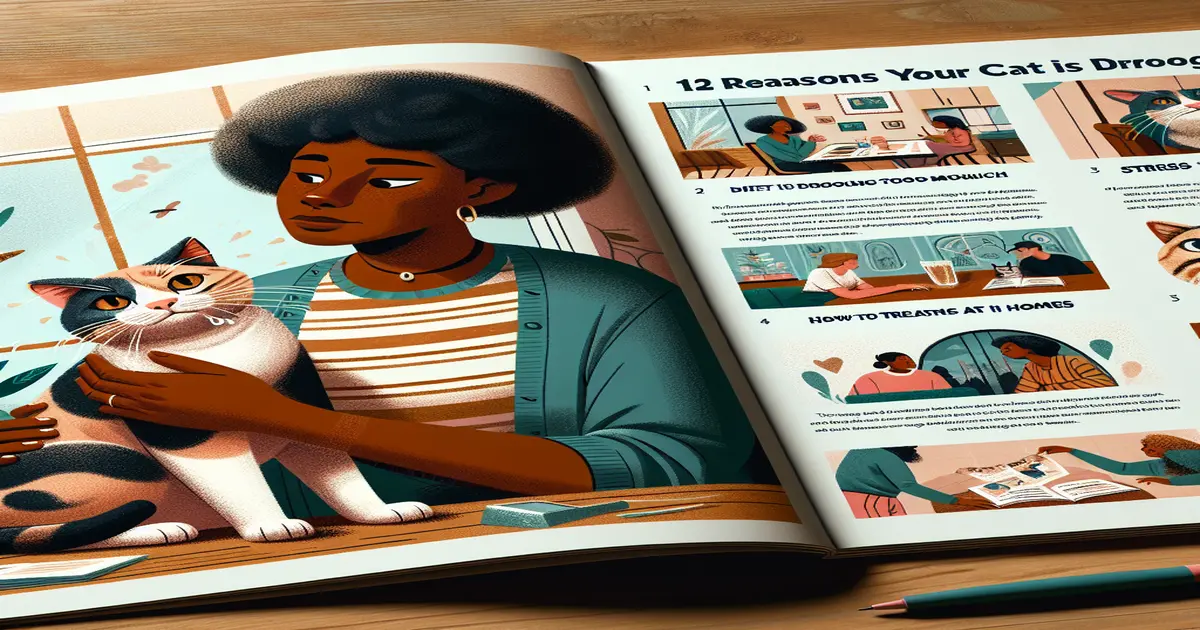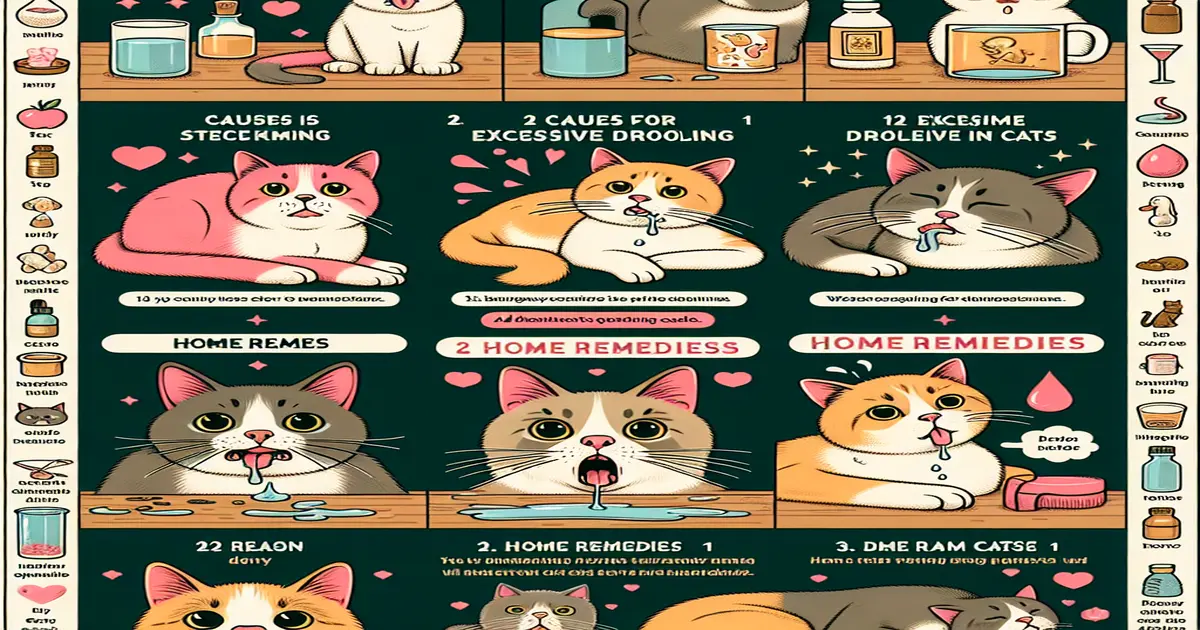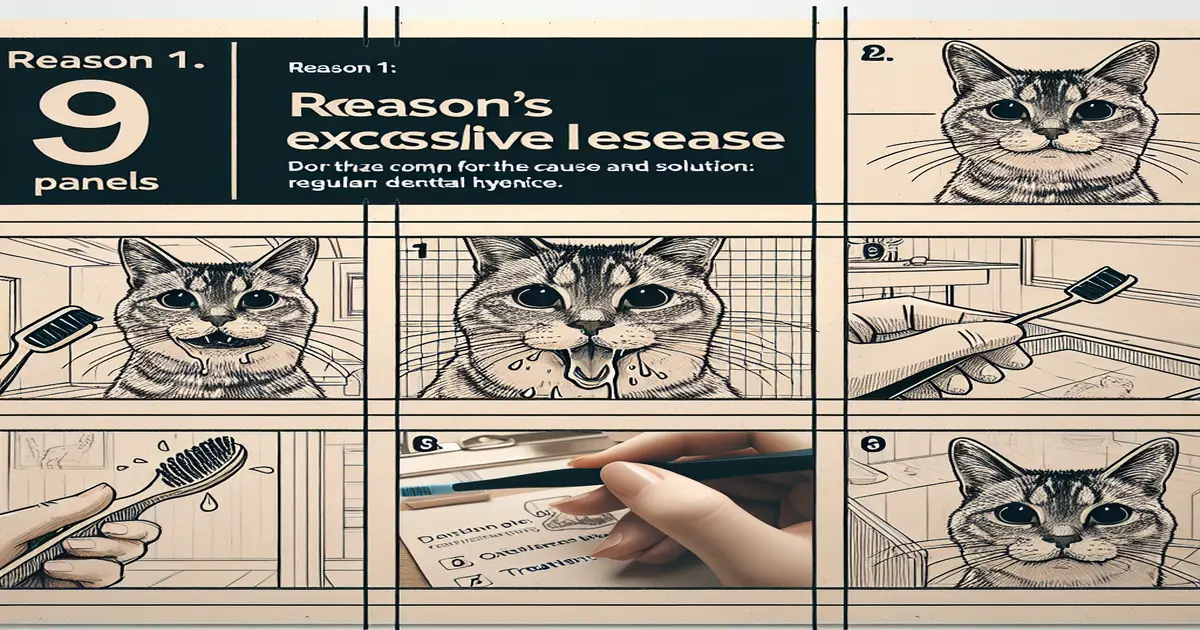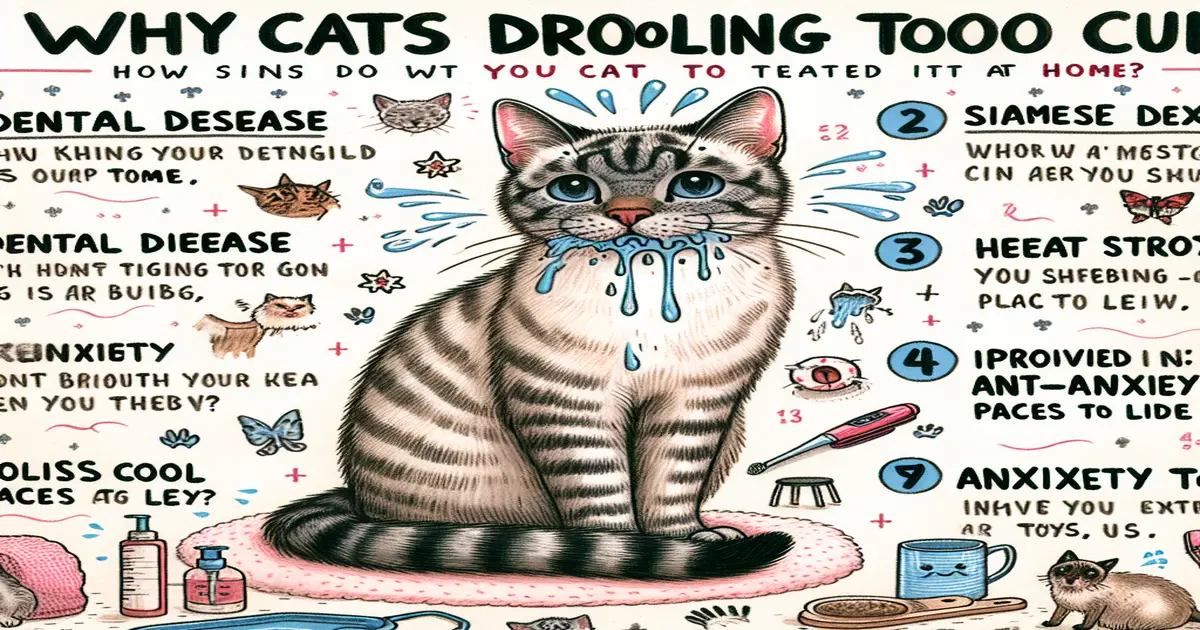Ever wonder why your cat is drooling excessively? It’s not just a dog thing—cats can drool too, and sometimes it’s a sign of something more serious. Understanding the reasons behind your cat’s drooling can help you take quick action to ensure your feline friend stays healthy and happy. This article dives into the 12 most common causes of excessive drooling in cats and offers practical tips on how to address them at home.
Importance of Recognizing Excessive Drooling in Cats
Why You Should Pay Attention
Excessive drooling in cats isn’t just a minor inconvenience; it can be an indication of more severe health conditions. Cats are masters at hiding discomfort, making it essential to notice the subtle signs.
Could It Be Serious?
Drooling might seem harmless, but it could indicate a severe medical issue. From dental disease to oral cancer, recognizing the symptoms early could save your cat’s life.
When to Seek Immediate Help
If your cat’s drooling is abnormal, don’t wait. Immediate veterinary care can make all the difference in diagnosing and treating the underlying causes effectively.

Most Common Causes of Excessive Drooling in Cats
Stomatitis
What is Stomatitis?
Stomatitis is the inflammation of the mouth, and it’s more common in cats than you might think. This condition results in red, swollen gums, throat, and sometimes lips.
Symptoms to Look For
If you notice your cat’s gums are red or swollen, or if they seem to be in pain when eating, it might be stomatitis.
Possible Causes
Dental disease or autoimmune issues are often the culprits behind stomatitis. A vet visit will help in diagnosing and treating this condition effectively.
Dental Disease
Symptoms of Dental Issues
Dental disease can cause painful gums, pus around the teeth, and even loose or missing teeth. If your cat seems reluctant to eat, this could be why.
Why It Causes Drooling
Infections in the mouth lead to excessive salivation as the body tries to cope with the irritation. Regular dental check-ups can help prevent this issue.
Veterinary Care Needed
Most dental issues require professional cleaning and possibly antibiotics. Maintaining oral hygiene at home can also help.
Foreign Objects in Mouth or Throat
Common Culprits
Cats, with their boundless curiosity, often find themselves exploring environments that can lead to trouble. They may end up with small toys, rubber bands, or even thread stuck in their mouths, as they enjoy batting and chewing on items that catch their interest. These objects can become lodged in their mouth or throat, causing discomfort or distress.
Immediate Action Required
If you suspect that your cat may have something lodged in its mouth, it’s crucial to inspect it immediately. Larger objects, which are visible and accessible, can often be carefully removed at home using gentle hands or tweezers, ensuring not to push the object further down. However, if the object is sharp or string-like, such as dental floss or sewing thread, it may cause more harm if you attempt to remove it yourself. In such cases, it’s best to seek veterinary intervention to avoid potential injury or complications.
Signs to Watch For
Frequent pawing at the mouth, gagging, or coughing are potential signs that something might be lodged in your cat’s mouth or throat. These signals should not be ignored, as they can indicate discomfort and the need for immediate attention to prevent further distress or injury.
Eating Something That Tastes Bad
Outdoor Adventures
Cats who venture outdoors, or even those who are curious about indoor plants, might nibble on items that taste unpleasant. This often results in drooling as a natural response to the bad taste and can be concerning to cat owners witnessing this behavior.
No Visible Changes
In cases where a bad taste is the culprit, there may not be any visible changes in the cat’s mouth. Contrary to other issues that may cause physical obstructions, the drooling should subside once the taste dissipates. It is important to monitor the situation to ensure the cat returns to its normal behavior.
Quick Fixes
Offering your cat some of their favorite food can help alleviate the bad taste in their mouth. Foods like tuna water or chicken broth can work wonders, as these flavors are appealing to most cats and can effectively mask any lingering unpleasantness.

Stress and Fear
Anxious Felines
Cats can drool when they are experiencing stress or fear. Events such as moving to a new home, being exposed to loud noises, or the introduction of a new pet in the household can trigger this physiological response. Cats are sensitive creatures and can exhibit stress in various ways, including drooling.
Temporary Drooling
Once the stressor is removed or the cat becomes accustomed to the new situation, the drooling typically stops. Identifying the source of stress is key to resolving the issue and ensuring your cat remains comfortable and relaxed.
Calming Solutions
Consider using calming sprays or diffusers designed specifically for felines. These products release soothing pheromones into the environment, helping to create a sense of calm. Additionally, providing a quiet space for your cat to retreat to when feeling anxious can be beneficial, offering them a sanctuary from stress-inducing factors.
Nausea and Pain
Common Causes
Nausea can result from various causes, such as car rides, gastrointestinal issues, or oral inflammation. These conditions can lead to drooling as the cat’s body reacts to the discomfort.
Signs of Nausea
Alongside drooling, other symptoms like vomiting, lethargy, or a lack of appetite may accompany nausea. It’s important to observe these signs closely, as they can indicate underlying health concerns that might require veterinary attention.
Temporary Measures
In some cases, withholding food temporarily and administering medications like famotidine can help alleviate nausea. However, it’s crucial to always consult with your veterinarian before providing any medication to ensure it is safe and appropriate for your cat’s specific situation.
Poison
Serious Symptoms
If your cat has ingested something toxic, you’ll notice drooling, wobbly behavior, rapid breathing, and potentially an odd smell emanating from them. In some cases, cats may also experience vomiting, lethargy, or seizures. It’s crucial to observe your cat closely for any sudden changes in their behavior or physical state.
Immediate Actions
In such scenarios, inducing vomiting or diluting the poison with water or milk can be initial steps to take, but it’s essential to consult a vet before proceeding as some substances can cause more harm if vomited. Immediate emergency veterinary care is crucial to prevent further complications and ensure your cat’s safety and well-being.
Common Poisons
Household cleaners, certain plants like lilies, and even some human foods such as chocolate and onions can be toxic to cats. Always keep these items securely out of reach. Be aware of medications that are safe for humans but harmful to cats, like ibuprofen and aspirin.
Oral Cancer
Where It Appears
Oral cancer commonly affects the tongue but can appear in other parts of the mouth as well, including the gums, cheeks, and throat. These cancers can be aggressive, making early detection vital to successful treatment.
Symptoms to Notice
Look for abnormal swelling, difficulty chewing, or unexplained weight loss. You might also notice your cat has bad breath or bleeding from the mouth. These could be signs of a tumor, and it’s important to consult a veterinarian if any of these symptoms appear.
Treatment Options
A biopsy is often required to accurately diagnose oral cancer. Depending on the stage and location of the cancer, treatment may involve surgery to remove the tumor, radiation therapy, or chemotherapy to target cancer cells. Post-treatment care is important to ensure your cat’s comfort and recovery.
Contagious Diseases
Types of Diseases
Rabies, calicivirus, feline leukemia, and Feline Immunodeficiency Virus (FIV) are some contagious diseases that can cause excessive drooling among other symptoms. These diseases can severely impact a cat’s health and quality of life, emphasizing the importance of prevention.
Infected Mouths
These diseases often result in painful, infected mouths, leading to drooling, ulcers, and inflammation. Vaccination can prevent some of these illnesses, reducing the risk of infection and promoting long-term health for your cat.
When to Vaccinate
Ensure your cat is up-to-date on vaccinations to prevent these contagious diseases from affecting their health. Regular veterinary check-ups can help keep track of their vaccination schedule and overall health.

Heat Stroke
Recognizing Symptoms
Heat stroke can cause drooling, abnormal breathing, bright red gums, and weakness in cats. It might also lead to confusion or lethargy. Recognizing these symptoms early is crucial, as heat stroke can rapidly progress to a life-threatening condition.
Cooling Measures
Use rubbing alcohol on their paw pads and cool water on the belly and other hairless areas to bring down their temperature. You can also place them in a cool, shaded area and offer small amounts of water to drink. Avoid using ice-cold water, as rapid temperature changes can be harmful.
Preventive Steps
Keep your cat indoors during extreme heat and ensure they always have access to fresh water. Providing a cool environment with fans or air conditioning can help maintain a safe temperature. Creating a shaded outdoor area can allow your cat to enjoy the outdoors safely.
Treating Drooling at Home
Stomatitis
Keeping the Mouth Clean
Maintaining oral hygiene is critical for managing stomatitis, a condition that causes inflammation of the mouth. Regular cleaning can help reduce pain and inflammation, making it more comfortable for your pet. Consider using chlorhexidine products, which are known for their antibacterial properties, after consulting your vet to ensure they are suitable for your cat’s specific condition.
Anti-inflammatory Options
Anti-inflammatory medications can be a valuable component of managing stomatitis symptoms. These medications help reduce swelling and discomfort, allowing your cat to eat and interact more comfortably. Always consult your vet to determine the appropriate treatment and dosage tailored to your pet’s needs.
Pain Management
Effective pain management is crucial for cats suffering from stomatitis. Your vet may recommend specific pain relief options that can provide significant comfort and improve your cat’s quality of life. These may include topical gels or systemic medications.
Dental Disease
Vet Visits Are Crucial
Dental health is vital for your cat’s overall well-being. Most dental diseases require veterinary care for proper diagnosis and treatment. Regular check-ups can help catch issues early, preventing more severe problems. Your vet can perform professional cleanings and identify dental issues that may not be apparent at home.
Maintaining Oral Hygiene
Maintaining your cat’s oral hygiene is essential to prevent dental disease. If brushing your cat’s teeth isn’t feasible, using chlorhexidine products can help maintain oral hygiene and reduce plaque buildup. Consult with your vet for safe and effective products that suit your cat’s needs.
Dietary Changes
Diet plays a crucial role in dental health. Consider dental diets specifically designed to help keep your cat’s teeth clean. These diets often have unique textures that help reduce plaque and tartar buildup. Your vet can recommend suitable options that fit your cat’s dietary requirements.
Foreign Objects in Mouth or Throat
Home Removal
Cats are curious creatures and can sometimes get foreign objects stuck in their mouths or throats. Larger objects can often be removed at home carefully. Use gloves and be gentle to avoid causing further harm. If you are uncertain, it is always best to seek professional help.
Vet Intervention Needed
If the object is sharp, string-like, or difficult to remove, veterinary intervention is necessary. String under the tongue poses significant risks and often requires surgical removal. Immediate attention from a vet is crucial to prevent complications.
Prevention Tips
Preventing such incidents is always better than treatment. Keep small items out of reach, and regularly inspect your home for potential hazards. Educating family members about these dangers can also help maintain a safe environment.
Bad Taste
Quick Remedies
Occasionally, cats may experience a bad taste from something they’ve ingested. Offer your cat a small amount of tuna or chicken broth to help eliminate the bad taste. This not only distracts them but can also help wash away the unpleasant taste.
Observe Your Cat
After offering a remedy, monitor your cat to ensure the drooling or discomfort stops once the bad taste is gone. If symptoms persist, it might indicate a more serious issue that requires veterinary attention.
Household Safety
To prevent bad taste incidents, keep plants and items that might taste unpleasant out of your cat’s reach. Regularly assess your home for substances that could pose a risk to your pet’s health.

Stress
Identifying Stressors
Cats are sensitive animals and can be affected by stress from various sources. Identify and remove stressors if possible, such as new pets, loud noises, or changes in the environment. Understanding your cat’s triggers can help minimize their anxiety.
Creating a Safe Space
Provide a quiet, secure space for your cat to retreat when feeling anxious. This refuge can be a designated room or a cozy nook. Calming sprays and diffusers can also contribute to a relaxing environment that reduces stress.
Long-term Solutions
For chronic stress, consider behavioral training or consulting a pet therapist for long-term solutions. These professionals can offer strategies to help your cat cope with anxiety and improve their overall well-being.
Nausea
Withholding Food Temporarily
If your cat shows signs of nausea, temporarily withholding food for a few hours can help determine if the drooling stops. This brief fast can help settle their stomach and manage nausea.
Medications
Certain medications, like famotidine, can aid in reducing nausea, but always consult your vet before administering any medication. Dosing and suitability depend on your cat’s health and medical history.
Dietary Adjustments
Your vet may recommend a bland diet to help manage nausea. Transitioning to easily digestible foods can alleviate symptoms and support your cat’s recovery.
Poison
Immediate Actions
If you suspect your cat has ingested poison, quick action is vital. Inducing vomiting or diluting the poison with water are immediate steps, but always consult your vet first to avoid worsening the situation.
Emergency Care
Seek emergency veterinary care immediately if you suspect poisoning. Time is critical, and professional intervention can save your cat’s life. Bring any packaging or evidence of the poison to the vet to assist in treatment.
Prevention
Preventive measures are key to avoiding poisonings. Keep poisonous substances, including certain foods and chemicals, out of reach and educate yourself on common household poisons that pose a risk to cats.
Oral Cancer
Diagnostic Measures
If you suspect oral cancer in your cat, prompt consultation with your vet is essential for a biopsy and further diagnostics. Early detection can significantly affect the outcome and treatment options available.
Treatment Options
Treatment for oral cancer often involves surgery, radiation, or chemotherapy. Your vet will provide guidance on the best course of action tailored to your cat’s condition and needs.
Alternative Treatments
While some alternative treatments may provide relief, they are often unproven. Discuss any alternative therapies with your vet to ensure they do not interfere with conventional treatments.
Heat Stroke
Cooling Measures
Heat stroke is a severe condition that requires immediate attention. Cool your cat down by applying rubbing alcohol to their paw pads and using cool water on their belly and other hairless areas. This process helps lower body temperature swiftly.
Monitoring Temperature
Keep a close watch on your cat’s temperature, and seek veterinary care if it doesn’t return to normal. Prolonged elevated temperatures can cause serious health issues.
Preventive Measures
To prevent heat stroke, ensure your cat stays indoors during extreme heat and always has access to fresh water. Providing shaded areas and avoiding strenuous activities on hot days can also help keep your cat safe.
Preventing Excessive Drooling
Keep Your Cat Indoors
Lower Risks
Keeping your cat indoors significantly reduces the risk of them eating harmful items like toxic plants or hazardous substances. It also limits their exposure to contagious diseases and parasites that outdoor cats often encounter. Outdoor environments pose various dangers, including traffic accidents and attacks from other animals.
Safe Environment
Create a stimulating indoor environment with plenty of toys, scratching posts, and climbing structures to keep your cat mentally and physically engaged. Consider adding a window perch for them to watch birds or other wildlife outside.
Regular Check-ups
Regular veterinary check-ups are crucial in detecting health issues early. Vets can assess your cat’s overall wellness and administer vaccinations and preventative treatments for common indoor health risks.
Oral Hygiene
Regular Cleaning
Regular cleaning of your cat’s teeth helps prevent plaque buildup and dental diseases, which can lead to drooling and other health problems. Use cat-friendly toothbrushes and toothpaste specifically designed for pets.
Chlorhexidine Products
For older cats or those resistant to brushing, chlorhexidine products in the form of oral rinses or gels can help maintain oral hygiene. These products can be used between professional cleanings.
Dental Diets
Consider specialized dental diets that are designed to reduce tartar buildup. These diets often include larger kibble that encourages chewing, which helps keep teeth clean.

Stay Up-to-Date on Vaccinations
Prevent Diseases
Vaccinations play a critical role in preventing diseases such as calicivirus and feline leukemia, both of which can cause symptoms like excessive drooling. Cats should receive vaccines according to their risk factors and lifestyle.
Regular Vet Visits
During regular vet visits, ensure your cat receives all necessary vaccinations. A vet can recommend a vaccination schedule tailored to your cat’s specific needs and health status.
Health Monitoring
Regular vet visits also provide opportunities to monitor your cat’s overall health, assess weight and nutrition, and detect any emerging issues early on.
Avoid Poison Exposure
Household Safety
Ensure your home is free from poisonous plants, such as lilies and poinsettias, and store cleaning products and other chemicals safely out of reach. Consider using child-proof locks on cabinets containing toxins.
Education
Educate yourself on common household poisons, including certain human foods like chocolate and onions, and ensure these items are kept away from your cat’s environment.
Immediate Action
If you suspect your cat has ingested something toxic, take immediate action by contacting your veterinarian or an emergency animal poison control center for guidance.
Check the Dryer Before Use
Prevent Tragic Accidents
Cats are naturally curious and may find warm, enclosed spaces like dryers inviting. Always check the dryer before use to prevent tragic accidents and ensure no cat is hiding inside.
Safety First
Make it a habit to check appliances and other small spaces where your cat might hide, such as washing machines, closets, and cupboards, to keep them safe.
Regular Inspections
Conduct regular inspections of your home to identify and mitigate potential hazards, ensuring a safe environment for your feline friend.
When to Seek Veterinary Assistance
Urgent Symptoms
Seek veterinary care if your cat exhibits symptoms like frequent vomiting, weight loss, gagging, coughing, or seizures. These could indicate serious health issues that require prompt attention.
Veterinary Role
Your vet will perform thorough examinations, including bloodwork, x-rays, and other diagnostics, to determine the cause of excessive drooling or other concerning symptoms.
Early Intervention
Early intervention can be critical in treating underlying health issues, improving your cat’s quality of life and preventing more serious health complications. Always follow your vet’s recommendations for treatment and follow-up care.
Conclusion
Excessive drooling in cats can indicate a variety of health issues, some minor and others serious. By understanding the common causes and knowing how to treat them at home, you can ensure your cat stays healthy and happy. Remember, when in doubt, always consult a vet to ensure your cat’s health.
FAQs
Why is my cat drooling excessively?
Excessive drooling can be caused by various factors such as dental disease, foreign objects in the mouth, or stress. It’s essential to identify the underlying cause to provide appropriate treatment.
Can stress cause my cat to drool?
Yes, stress and anxiety can cause cats to drool. Identifying and removing the stressor can help alleviate the drooling.
How can I prevent my cat from drooling excessively?
Regular dental care, keeping your cat indoors, and staying up-to-date on vaccinations can help prevent excessive drooling. Additionally, removing poisonous items and checking household appliances for hiding spots can reduce risks.
When should I take my cat to the vet for drooling?
Seek veterinary care if your cat exhibits symptoms such as frequent vomiting, weight loss, gagging, coughing, or seizures. Early intervention can make all the difference in treating underlying health issues.
Can I treat my cat’s drooling at home?
Some causes of drooling can be treated at home, such as bad taste or mild stress. However, it’s essential to consult a vet for more serious issues like dental disease, poisoning, or oral cancer.



